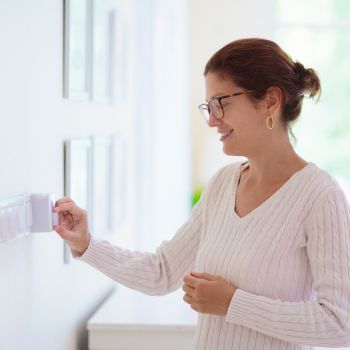How the Thermostat Affects Your HVAC System
 Although the thermostat is used to regulate the temperature of your home, it’s often seen as disconnected from the rest of the HVAC system. Factors like wear and tear or clogged filters can affect performance, but poor temperature sensing can also drive up electric bills and contribute to inefficient heating and cooling. Learn more about the relationship between the HVAC system and thermostat.
Although the thermostat is used to regulate the temperature of your home, it’s often seen as disconnected from the rest of the HVAC system. Factors like wear and tear or clogged filters can affect performance, but poor temperature sensing can also drive up electric bills and contribute to inefficient heating and cooling. Learn more about the relationship between the HVAC system and thermostat.
What Does the Thermostat Do?
In your home or commercial building, the thermostat functions as the control for the HVAC system. This interface is used to adjust the temperature and determine how warm or cool it feels inside. To achieve your ideal temperature, settings indicate to the HVAC system how much hot or cool air is needed.
When a thermostat doesn’t accurately read the room’s temperature or transmit signals to the rest of the HVAC system, components may operate incorrectly or not turn on at all. For instance, repeat cycling occurs when the furnace or air conditioner turns on and off in rapid succession, causing a space to feel warmer or cooler. These factors result in wasted money and a room that never feels quite comfortable.
Factors Affecting the HVAC System and Thermostat
A disconnect in this relationship can also result in sudden malfunction or HVAC system failure and increased energy costs.
Poor Signaling
Most issues come down to how the thermostat reads temperatures and transmits this information to the HVAC system. This factor may be attributed to:
- A Power Issue: For example, the batteries may have died or a blown fuse in the electrical service panel may prevent the system from turning on. In these cases, you adjust the temperature manually but the HVAC system doesn’t respond.
- Debris: Thermostats can accumulate dust, dirt, soot from fireplaces and cigarette smoke over time. Any coating that forms can influence how well the device perceives the internal temperature of your space and transmits this information. Cleaning the thermostat can help improve the reading.
- Connection Issues: A poor connection between the thermostat and air conditioner can result in a blower fan that won’t turn on, is constantly on or won’t blow cool air.
Poor Positioning
Location can play a role in how well a thermostat records the room temperature. In these cases, the device takes an inaccurate reading and relays this faulty information to the HVAC system. Common scenarios include:
- Improper Level: Poor installation can prevent a thermostat from taking an accurate reading. Make sure the device is roughly at eye height and positioned parallel to the floor, rather than at an angle.
- Too Much Sun and Cold: A thermostat in a room that gets a lot of sunlight often perceives the space as being constantly warm. In response, the heat rarely activates or cold air may blow unexpectedly. If the device is positioned near a door, it regularly records drafts from outside and attempts to warm the room by routinely turning on the furnace or heater. Considering these effects, the thermostat should never be placed in direct sunlight or a heat-generating device and should be situated at least five feet from the door.
- Heat Anticipator Issues: For mechanical models, a heat anticipator stuck in place cannot take an accurate temperature reading.
Efficiency Issues
Additional factors can lead to inaccurate temperature readings or excessive operations that drive up energy costs, including:
- Using An Older Thermostat: Programmable digital thermostats take more accurate temperature readings than older manual ones and can be adjusted to suit the specific heating and cooling needs of your home.
- Short Cycling: Often in response to inaccurate temperature readings, the air conditioner’s compressor will shut off before completing a full cooling cycle and turn on soon after. If the anticipator hasn’t been calibrated properly, shorter and more frequent cooling cycles may result. This pattern places greater strain on the whole system and drives up electrical bills, while your home never fully cools down or warms up.
- Uneven Cooling: A poorly calibrated thermostat can result in an inaccurate temperature reading that causes the air conditioner or heater to operate for longer cycles. This can result in areas that are significantly warmer or cooler than others.
Are you concerned about the performance of your HVAC system? Whether for residential or commercial use, MJ Fahy & Sons can inspect all components and recommend any upgrades or repairs. To schedule service, contact us today.




